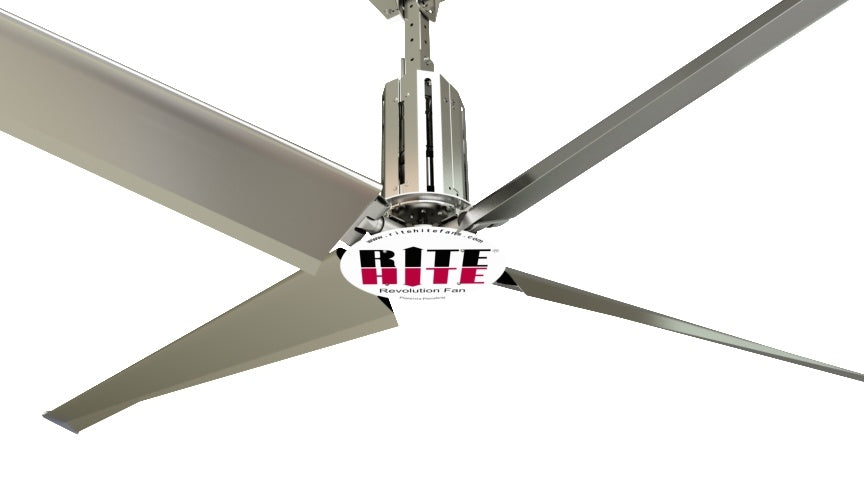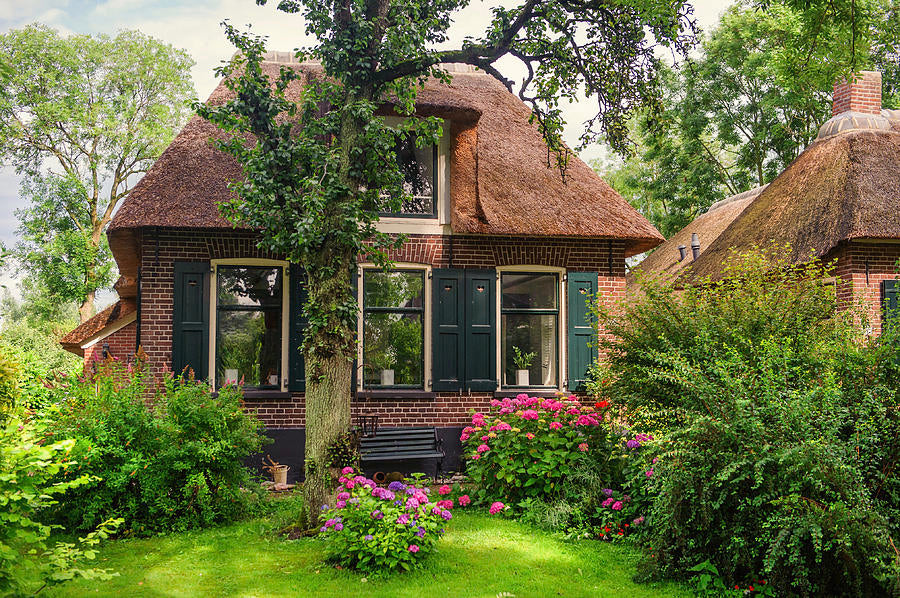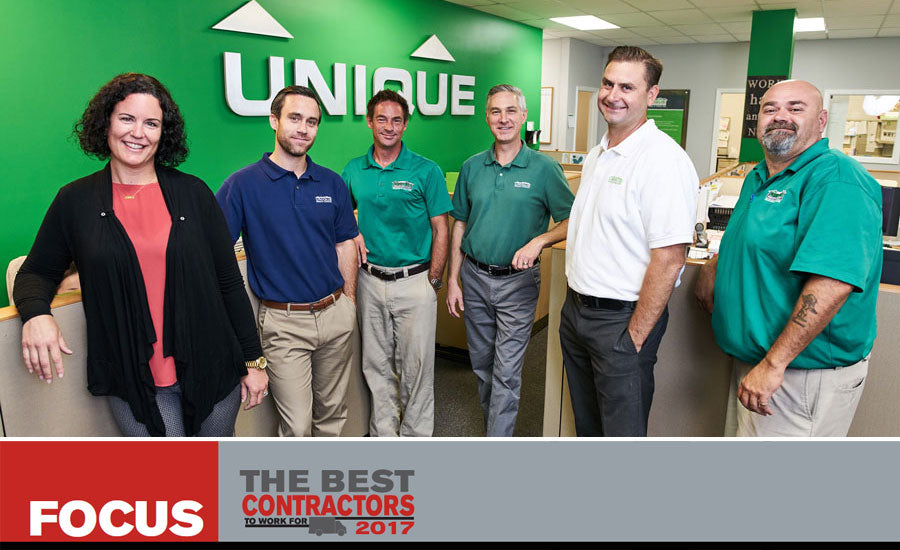
High-efficiency Air Movement Options Remain in High Demand
Occupant comfort, energy savings, and increased efficiency goals are driving consumers’ demands

HVLS FANS
Andy Olson, director of marketing, Rite-Hite Fans, said the demand for HVLS fans continues to grow, especially in a variety of industrial and commercial applications.
“While keeping people cool has been the goal of fans for decades, HVLS fans are providing additional benefits above and beyond traditional ceiling or wall fans,” he said. “This includes supplementing HVAC systems. Whether it’s in heating in the winter or cooling in the summer, HVLS fans can reduce the workload on existing equipment, which saves money by raising/lowering thermostat set points and creates a more comfortable environment. Places like health clubs, sports facilities, and other areas where air can get stagnant are reaping the benefits.”
The 4-blade Rite-Hite Rave Fan is designed for large commercial/retail spaces that have high ceilings and need to move large amounts of air. One fan can cover almost 8,000 square feet and may be painted to match/complement the space.
“The blade and hub design of Rite-Hite’s fans allows them to move more air over a larger space using fewer blades, which, in most cases, results in the need for fewer fans,” he continued. “The way fans are controlled is evolving. People want to be able to control their fans from a variety of smart devices and, in many cases, multiple fans from one device. In addition, more energy-efficient motors are being developed, which will bring the operational costs of HVLS fans down even lower.”
Barry Warner, president, MacroAir, said large horizontal ceiling fans are being sought in environments ranging from 4-24 feet.
“It is no longer a market where only the largest diameter fans are considered. It’s important to look at fans of all diameters as they’ve evolved to meet the needs and resolve issues in a variety of spaces,” he said. “The potential application environments have very few limitations.
“Building design is evolving to be more efficient and demanding better ways to distribute and destratify air,” Warner continued. “HVLS fans have long proven to be among the most cost-effective and efficient ways to move air and provide human comfort. They help reduce air conditioners’ operational costs and furnaces’ heating costs and balance temperatures within a space. There is a simple reason many of the largest corporate names in the world have adopted HVLS fans in their new and existing buildings — they provide tangible results.”
For greater efficiency, all of MacroAir’s latest products feature gearless power units.
“We can now supply the power to drive up to 24-foot-diameter fans very effectively in industrial spaces. In addition, our HVLS products have zero risk of oil leaking from a gearbox. We’re also now able to ignore typical voltage spikes in buildings that knock out variable frequency drives [VFDs] by having a broad voltage input range feature that sees voltages dip and surge as normal, which allows the fans to keep operating. We’ve addressed the most common historical issues and inconveniences with HVLS fans that existed due to their old designs using a/c motors, gearboxes, and VFDs.”
Energy Star qualifications often drive consumer interest, and Delta Breez commonly uses these figures to entice homeowners.
Rita Carbone-Lawson, national sales manager, Breez Ventilation Products, said many of today’s homes are airtight and highly insulated, so proper ventilation is essential for good IAQ.
“To accomplish this, Delta Breez uses state-of-the art brushless DC [BLDC] motor technology in all our fans with a broad range of functionalities and features that appeal to today’s homeowners,” said Carbone-Lawson. “The new Delta Breez Signature Series offers a choice of adjustable high speed and adjustable low speed for continuous operation and compliance with ASHRAE 62.2, worry-free operation with a built-in motion sensor and/or humidity sensor, a built-in Bluetooth speaker, and energy-saving LED lighting. We also notice that more and more home builders are going green and establishing sustainability initiatives that can be satisfied with Energy Star-qualified bath fans with enhanced feature functions. Utility companies are beginning to include Energy Star bathroom fans in their consumer rebate programs to encourage use.”
“Bathroom fans have the highest demand in new construction in both single-family and multifamily units, but the decision is not made by the homeowner; rather, the decision is typically code-driven,” said Ozden Karakurt, southeast regional sales manager, Field Controls LLC. “Bathroom fans are being positioned at the lowest cost possible to meet the current code, which shows a clear lack of understanding of how bathroom fans and other exhaust devices depressurize a home and the impact of depressurization to the home’s IAQ.”
ERVs AND HRVs
Chris Chase, product marketing manager, Aprilaire, said the driving force behind the growth in ventilation product sales is the resurgence in residential new construction (RNC).
“In order to comply with energy and building code changes, builders of both single-family and multifamily structures have incorporated mechanical ventilation,” he said. “Consumers are generally not aware of the presence of their ventilation systems unless builders are promoting their homes as being Energy Star-compliant. Older homes are leaky compared to the insulated, foamed, or encapsulated homes of today. Therefore, there has been little interest in the retrofit market for ventilation products. This will change as older homes are sealed in order to be more energy efficient. These tighter structures will require mechanical ventilation to prevent moisture build up inside the home.”
Aprilaire’s primary focus has been with supply ventilation products like the Model 8140 and Model 8142 Fresh Air Ventilators, said Chase.
“They are designed to bring in the correct amount of fresh air to meet energy and building codes in the RNC market,” he said. “They use the home’s HVAC system to distribute and condition incoming air. Many builders and contractors prefer to differentiate their ventilation offerings by using one of these types of products. While they have been around for a number of years, relatively few contractors in the U.S. previously installed them on a regular basis. That is changing as building and energy codes continue to evolve.”
Jim Shelton, vice president, Panasonic Eco Solutions, believes ventilation has had an extremely difficult time gaining recognition as an important part of the building process.
“Ventilation is hard to visualize, and until it became a prominent part of the building codes, it was largely ignored,” Shelton said. “But, as whole-house ventilation continues to become a larger focus for builders as a result of increased demand for tighter built homes, they are requesting products that meet building codes, remain sustainable, and deliver superior IAQ. Builders and homeowners alike are increasingly understanding the benefits of investing in a higher quality solution that will perform better, last longer, and save energy in the long run.
Designed for multifamily dwellings and new airtight homes, Panasonic’s Intelli-Balance 100 is a cost-effective, code-compliant ERV for any North America climate zone.
“The high-performance, high-efficiency ERV removes potentially toxic air and replenishes it with clean, healthy air for improved IAQ,” said Shelton.
Ed Reynolds, director OEM sales, northeast regional manager, Field Controls LLC, explained that while much of the ventilation business is driven by codes, building practices leading to tighter home construction are requiring contractors to consider ventilation options regardless of code requirements.
“As we all know, a home must breathe,” said Reynolds. “Tighter home construction with improper ventilation leads to elevated humidity levels within homes as well as increased levels of odors, volatile organic compounds, pathogens, and dust. Field Controls’ ventilation solutions allow homes to breathe properly and alleviates these issues. Field Controls’ HRVs and ERVs offer homeowners a premium solution to proper ventilation and 24/7 fresh air for optimized indoor comfort and maximum energy efficiency.”
Field Controls recently expanded its offering in the premium level HRV/ERV category, offering HRV and ERV models ranging from 80-200 cfm for residential applications and 300-1,200 cfm for commercial applications.
Amol Joshi, product manager, Ruskin Rooftop Systems, believes both ERVs and dedicated outdoor air systems (DOAS) are the two technologies on the lips of engineers and the contracting community.
“There has also been a lot of discussion on HVAC load reduction [HLR], primarily because of the newness factor in the world of ventilation and IAQ,” he said. “The key demand drivers are really the energy zones in North America. The East Coast and southern Texas regions have a particular type of weather zone where sensible and latent heat transfer is respected. The payback on ERVs and DOAS is as quick as zero to two years. In southern Canada and the central region of the U.S., the payback is two to seven years for the same ERV. So, demand is region-based.”
Ruskin’s MV1500 is being developed on one end of the spectrum, and there is a double-walled ERV with heating and cooling built in on the advanced side.
In June, Ruskin Rooftop Systems will introduce the 6,200-cfm stand-alone ERV, designed for both indoor and outdoor applications to satisfy market demands.
“We are moving from single- to double-wall construction — 1-inch thick,” said Joshi. “We plan to expand well beyond the 7,400-cfm ranges later this year. These new ranges will also feature the time-tested rigid wheel and state-of-the-art controls from Ruskin’s parent company, Johnson Controls.”
In 2017, Airxchange Inc. announced an increase in its range up to 126 inches in diameter for wheels that are most commonly used for semi-custom and custom air-handling units.
“This increases the maximum cfm range of the product by almost 60 percent,” said Richard Taft, senior vice president, sales and strategy, Airxchange. “In addition to more choices for either high thermal effectiveness and/or air pressure drop, Airxchange still offers its exceptionally serviceable energy recovery wheel with segments that can be removed without the need for special tools or disruptive disassembly. All of our segments are face-loaded and require minimal service clearance, which allows our OEM partners to design air-handling systems with some of the smallest mechanical room footprints.”
AIR CURTAINS AND THE UNICO SYSTEM
Outside of ERVs, HRVs, and HVLS fans, both air curtains and high-velocity systems are also seeing heightened demand from consumers.
“Companies are looking to provide the best experience they can for customers, employees, and visitors to help attract and retain them,” said Miranda Berner, marketing director, Berner Intl. “Keeping the space around the inside of the door comfortable is one of the many details people notice and appreciate. Learning that air curtains are also saving energy while keeping the space comfortable is the icing on the cake. The other driving force to this demand is the inclusion of Air Movement and Control Association Intl. Inc. (AMCA)-certified air curtains as alternatives to vestibules in the International Energy Conservation Code (IECC) and International Green Conservation Code (IgCC) building codes, Berner said. Berner Intl. has heated and unheated, AMCA-certified air curtains to meet this code that also meet the design aesthetics of the space.
“To make it easier for specifiers and building owners to meet these building codes with air curtains that have designs worthy of the main entrance, Berner Intl. added AMCA-certified steam-, hot water-, and electric-heated air curtains to its most popular main entrance air curtains,” said Berner. “We also added the Venturi Heater to all of our architectural designs with the exception of our low-profile series. The Venturi Heater fits on the outside of the fan housing and allows air to be warmed without blocking the flow of the airstream. It elegantly solves the issue of having to either place the heating coil in the intake, which causes the temperature to drop a few degrees, or in the outlet nozzle, causing the airstream to be disrupted.”
Scott Intagliata, marketing director at Unico Inc., agreed that comfort and saving space are integral to consumer demand. He also said that more and more consumers want the ability to bring in programmed amounts of fresh air through motorized vented systems and HRVs.
“Newly constructed homes are getting tighter and tighter, and having fresh air brought in has numerous benefits for health and comfort, like preventing mold and reducing indoor pollutants,” said Intagliata. “People are very tuned into this. When installers follow our installation instructions, there is little to no thermal loss or air leakage. In fact, a LEED [Leadership in Energy and Environmental Design] project at the University of Kentucky measured four Unico Systems in operation and found no air leakage at all. Our product has flexible supply tubing that comes in R-4, -6, and -8 versions. Adding to this, our fasteners and connectors all come in easy-to-use boxed kits, saving installers both time and hassle on-site.”
Source: https://www.achrnews.com/articles/135004-high-efficiency-air-movement-options-remain-in-high-demand


